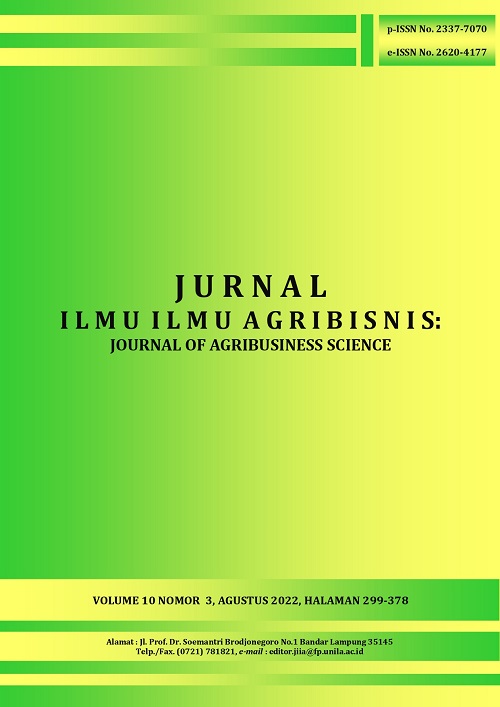ANALISIS SISTEM AGRIBISNIS PORANG DI DESA HANURA KECAMATAN TELUK PANDAN KABUPATEN PESAWARAN
DOI:
https://doi.org/10.23960/jiia.v10i3.5972 Abstract View: 427
Abstract View: 427
Abstract
This study aims to determine the provision of porang farming production facilities, porang farming income, porang processing, porang marketing, and services that support porang agribusiness activities. This study uses a survey method. The research location was deliberately chosen in Hanura Village as the center for porang production. The research was conducted in March-April 2022. Respondents in this study were porang farmers, porang traders, and providers of porang production facilities. The selection of 20 porang farmers used a purposive sampling method. Determination of respondent traders and suppliers of Porang inputs used the snowball method. Data were analyzed using criteria 6 T, R/C, marketing channel, marketing margin, and farmer’s share. The results showed that if the provision of seeds, fertilizers, pesticides, and agricultural tools has met criteria 6 correctly. The total income obtained from porang farming is Rp75,647,290 per hectares with R/C for a total cost of 3.41, meaning that porang farming is profitable. Farmers have not yet processed porang tubers into semi-finished raw materials or other derivative products. Porang farmers only processed porang tubers only through harvesting, collecting, sorting and storage. Porang marketing in Hanura Village consists of one marketing channel and is efficient with a farmer's share of 81,25 percent. Services that support porang agribusiness are farmer groups, financial institutions, extension agencies, transportation, government regulations, and agricultural shops.
Key words: agribusiness, farming, marketing, porang.
Downloads
Downloads
Published
How to Cite
Issue
Section
License
Authors who publish with this journal agree to the following terms:
Authors retain copyright and grant the journal right of first publication with the work simultaneously licensed under a Creative Commons Attribution License that allows others to share the work with an acknowledgement of the work's authorship and initial publication in this journal.
Authors are able to enter into separate, additional contractual arrangements for the non-exclusive distribution of the journal's published version of the work (e.g., post it to an institutional repository or publish it in a book), with an acknowledgement of its initial publication in this journal.
Authors are permitted and encouraged to post their work online (e.g., in institutional repositories or on their website) prior to and during the submission process, as it can lead to productive exchanges, as well as earlier and greater citation of published work (See The Effect of Open Access).














